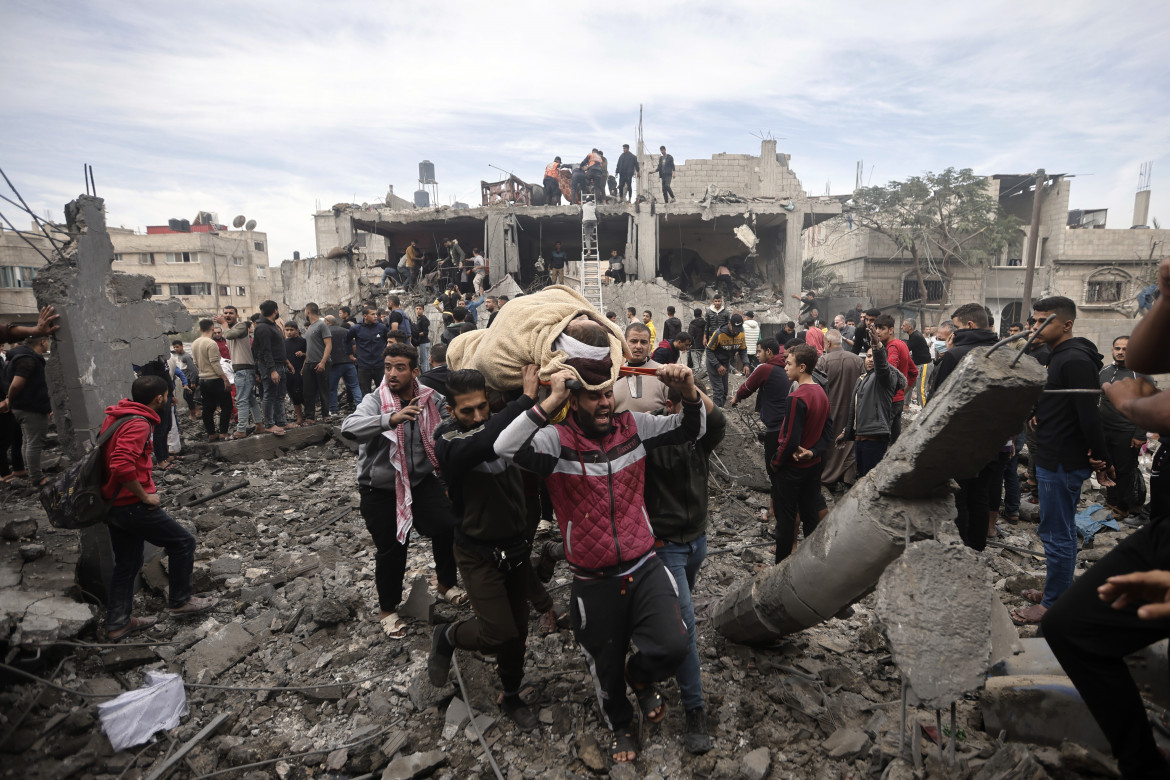Analysis
100 days into the Israeli warpath, bodies in the streets and the living line up for rations
Israel has killed 23,843 people in Palestine, a campaign conducted ‘with almost no regard for the impact on civilians,’ a UN official said.

When the blasts and explosions subside and only the hum of drones remains to break the silence of Gaza’s rubble, the patients who are able to walk try to leave Al-Aqsa Hospital, in the center of the area of the Strip under attack. This is dangerous: they must cross a war zone designated by the Israeli army. But they do it anyway, because they are desperate.
Monther Abu Their managed to get away four days ago. “I didn’t feel safe in the hospital, the explosions were getting closer and closer. I summoned up all my courage and went outside. I walked in the fear that I would be hit by a blast. God protected me and I managed to reach a group of people without being harmed,” Abu Their told a Palestinian journalist.
There is no electricity left at Al-Aqsa Hospital, standalone generators are down, and only minimal care is provided for the wounded and sick.
“It’s very risky for patients who are trying to leave,” Dr. Tareq Abu Azzoum explained to Al Jazeera TV. “The hospital is located in an area considered a battle zone.” Azzoum added that Israeli forces have positioned themselves a few hundred meters from the health facility as they try to take full control of the Salah al-Din highway that ran through all of Gaza before it was destroyed in several places by aerial bombardment and the passage of bulldozers and tanks.
The situation at Nasser Hospital in Khan Yunis is similar to Al-Aqsa. Footage released by the Reuters news agency shows patients lying on stretchers in hospital corridors and doctors using cell phones to shine a light on patients. “We have no more beds. The medicine in the emergency room is insufficient. We are trying to find alternatives,” warned Dr. Mohammed al Qidra.
These accounts are in sharp contrast with the Israeli army’s version, which claims “respect for civilians and international humanitarian laws in Gaza,” a notion repeated dozens of times in recent days by official Israeli representatives in the proceedings at the International Court of Justice in The Hague that sees the Jewish state accused of genocide.
On Friday night, 13 people, including a two-year-old girl, died in an airstrike on two homes in Rafah. Bassem Arafeh, a relative, said the families were eating dinner at the time of the raid and showed a photo of a little girl to the press: “This child was hungry, she died while eating a piece of bread with nothing on it. Where is the International Court of Justice when our children die? Where are the Muslims … and world leaders?” asked Arafeh, addressing local journalists.
The Israeli military reported that on Monday its forces killed dozens of fighters affiliated with Hamas and other armed groups in Khan Younis and central Gaza. For its part, the Islamic movement claimed it had fired at a military helicopter in southern Gaza. Firefights, gunfire and airstrikes also took place in the Al Bureij, Al Nusseirat and Al Maghazi refugee camps. Palestinian witnesses reported that an Israeli missile exploded within a few meters of a bus. There were more than 20 casualties in northern Gaza, Beit Lahiya and the Daraj neighborhood of Gaza City. Gaza’s Health Ministry reported 135 Palestinians killed and 312 wounded between Friday and Saturday.
In total, since October 7, the death toll stands at 23,843.
There is no room left for interpretation in the account given on Friday at the UN by Under-Secretary-General for Humanitarian Affairs and Emergency Relief Martin Griffiths. The Israeli campaign in Gaza has been conducted “with almost no regard for the impact on civilians,” the U.N. official denounced, adding that Palestinians may not be able to return to northern Gaza, largely razed by air strikes. “The health system is in a state of collapse. Women are unable to give birth safely. Children cannot get vaccinated. The sick and injured cannot get treatment. Infectious diseases are on the rise. And people have been seeking shelter and refuge in hospital yards,” he reported.
Citing U.N. staff who visited the northern part of Gaza, Griffith described the situation as “horrific,” with bodies abandoned in the streets and hungry people stopping trucks to ask for food and basic necessities. Finally, he pointed out that U.N. shelters are overflowing and that water and food are running out.
In the West Bank, at least 10 Palestinian youths were injured and five arrested during an assault by Israeli military units on the Al-Faraa camp that lasted several hours. Raids and arrests took place in the Hebron area after an assault on a settler outpost attempted by three Palestinian youths, all of whom were killed by the military.
The Israeli side is stressing that we are 100 days into the kidnapping of some 240 hostages by Hamas and other Palestinian groups. More than 130 of these hostages remain captive in Gaza, and families and Israeli authorities have organized solidarity demonstrations and sit-ins across the country to demand their release. Hamas has reportedly agreed to let the Red Cross deliver much-needed medicine to the Israeli hostages. In Tel Aviv, several thousand people gathered in Habima Square on Monday night called for the immediate resignation of Prime Minister Netanyahu and his government.
Originally published at https://ilmanifesto.it/cento-giorni-i-morti-per-strada-e-i-vivi-in-fila-ai-camion-di-aiuti on 2024-01-14
